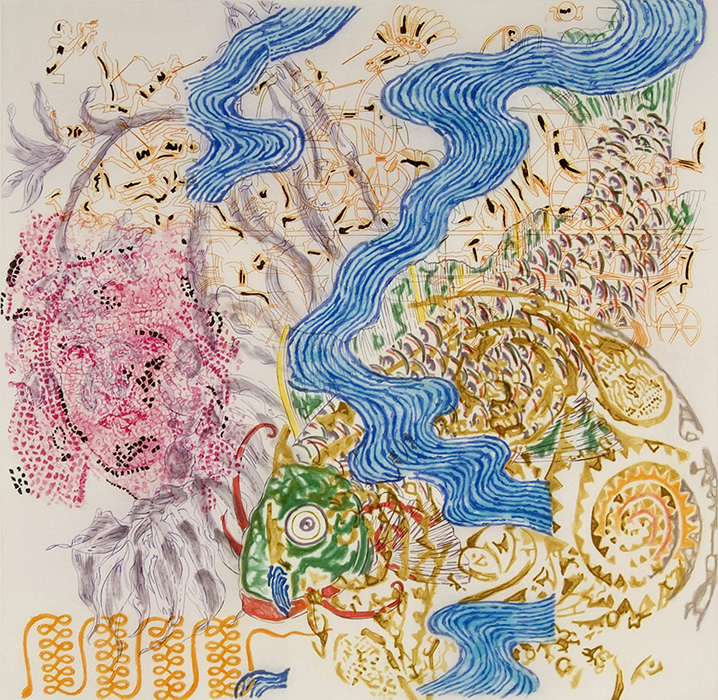In the last entry of this blog, I wrote about the American painter Wolf Kahn, whom the art historian Barbara Novak regarded as perfectly blending the American landscape tradition with the formal innovations of Abstract Expressionism.1 In this post I will examine Nancy Graves, another artist who owed a formal debt to the Abstract Expressionists while exploring very different subjects in her work. Graves, who was born twelve years after Kahn, came from a younger artistic generation. Instead of the Hans Hofmann School, she studied English literature at Vassar before attending the Yale School of Art for her MFA. While there, she studied with a group of artists including Chuck Close, Richard Marden, Janet Fish, Brice Marden, and Rackstraw Downes, all of whom helped to set the terms of American art after the era of Abstract Expressionism’s dominance.2 These artists, working in a variety of mediums and traditions, including photorealist painting, sculpture, Conceptual art, and a suddenly resurgent figurative expressionism, seem at first glance to have little in common with each other, let alone with the intensely personal, large scale abstractions created by Jackson Pollock, Willem de Kooning, and others of their generation.
Yet, as both artists and art historians have noted, Graves and her colleagues entered an art world irrevocably altered by Abstract Expressionism. In particular, the artist Allan Kaprow noted that Pollock had severed painting from the responsibility to be a window on the world, instead freeing up the artist to allow elements of the world back into painting. In Pollock’s case, this was accomplished through his translation of the gestures of his body onto the painted surface.3 In particular, Abstract Expressionism, no matter how it was practiced by individual artists, led to the predominant mode of painting becoming an allover style of composition, originating with Cubism, that saw the painting occupy the entire canvas. The canvas, further, was usually presented unframed, completely denying the aforementioned window-on-the-world quality that had so long been central to the Western tradition.4 In her paintings Graves, who also worked extensively as a sculptor, combined this allover compositional style with a dense series of references to science and art, combining the very old—Paleolithic cave paintings, paleontology—with the modern and even futuristic, including NASA satellite photographs and modern art movements like Cubism and Fauvism.5

Graves—who called her painting post-cubist—increasingly in her later career combined all of these references at once, creating densely-layered and complex visions of a variety of natural and human phenomena.6 The 1991 print Time Shapes the Stalactites is a stellar example of this process at work. In the left center, rendered in pink and black in a mix of pointillism and minutely swirling lines, is a fourth-century Roman head, a frequent motif in Graves’s work of the time. This pointillist style, though it references the history of art, is also related to Graves’s close study of geographic survey maps.7 Her study of maps was reinforced by the wonders of NASA’s first satellite images, released to the public while she was establishing her artistic identity.8 The flowing blue lines that move from top to bottom of this print are likely references to the stylized way rivers are represented on maps, and the work’s title directly calls forth the natural processes that have shaped the world we live in, in particular the flows of water that cascade across the print’s surface. The image rewards closer examination, with an astute viewer able to pick out warring figures on horseback and chariot, spirals reminiscent of seashells, plantlike forms rendered in ghostly purple, and a large fish, rendered in luminous green, goldenrod, and a dark, bricklike red.
Graves executed this work—a bravura combination of intaglio printmaking techniques and silkscreen—in collaboration with the Italian print studio 2R Edizioni d’Arte. In her early fifties she was settled into a mature, confident style, bringing together the many interests she had explored since her childhood among the taxidermy collections at the Berkshire Museum in her native Pittsfield, MA.9 Unfortunately, Graves made her last works just a few years later, in 1995, succumbing to ovarian cancer in October of that year. Works like these, along with the complex, three-dimensional blends of painting and sculpture she was making during the early 90s, thus also serve as bittersweet reminders of what new and fascinating directions her art might have taken over the last twenty-five years.10
1 Barbara Novak, “Introduction,” in Wolf Kahn Pastels (New York: Harry N. Abrams, 2000), 7.
2 Nancy Graves, Linda Konheim Kramer, and Ameringer & Yohe Fine Art (N.Y.), Nancy Graves: A Retrospective. (New York: Ameringer & Yohe Fine Art, 2005), 3.
3 “Nancy Graves: Back to Nature, Robert Storr,” n.d., 9–10.
4 Graves, Kramer, and Ameringer & Yohe Fine Art (N.Y.), Nancy Graves, 3–4.
5 Christopher Lyon, “Nancy Graves: In the Desert of Style,” in Nancy Graves., 2015, 31–36.
6 Joanna Weber, “Of Colored Bones and Metal Rods: Nancy Graves’s ‘Calegli,’” Yale University Art Gallery Bulletin, 1997, 92.
7 Lyon, “Nancy Graves: In the Desert of Style,” 32.
8 Nancy Graves and Mitchell-Innes & Nash, Nancy Graves: Mapping., 2019, 11–13.
9 Graves, Kramer, and Ameringer & Yohe Fine Art (N.Y.), Nancy Graves, 3.
10 Graves, Kramer, and Ameringer & Yohe Fine Art (N.Y.), 6.



